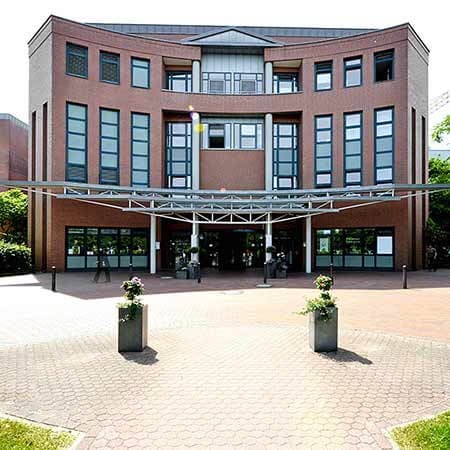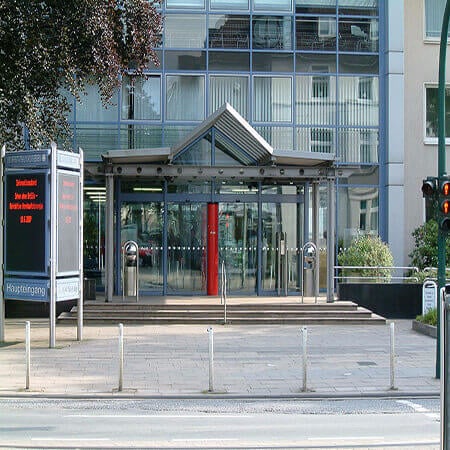Mitral valve stenosis is one of the most common medical diagnoses. Isolated mitral valve stenosis is observed in about half of all diagnosed patients. In the remaining cases, there is a combined mitral pathology, which usually is a combination of stenosis and mitral insufficiency, or a complex heart defect – a combination of mitral and aortic defects. The common cause of mitral valve stenosis is rheumatic endocarditis. The disease often begins in childhood or adolescence and gradually progresses.
Content
- Overview
- Symptoms of mitral valve stenosis
- Treatment tactics
- Surgery and the stages of mitral valve stenosis
- Prognosis
- Complications of untreated mitral valve stenosis
- Why undergo treatment in European hospitals?
- The cost of treatment in European hospitals
- Treatment in Europe with Booking Health
Overview
The mitral valve is affected in 90% of cases of all heart diseases. Separately from other diseases, mitral valve stenosis occurs in 1/3 of all mitral defects. In about 40% of patients, it is combined with mitral valve insufficiency. There are usually about 80 patients with mitral valve stenosis per 100 000 population. This disease usually begins to develop in people after 30 years of age and is found more frequently in female patients.
Mitral stenosis is found in 45% of people with diseases of rheumatic nature: arthritis, vasculitis (inflammation of the blood vessels), Takayasu's disease, and such severe connective tissue diseases as systemic lupus erythematosus.
Considering all the causes of the disease, mitral defects can be divided into three groups. The first group implies congenital stenoses with changes in the structure of the mitral valve. They arise at the stage of intrauterine development, more precisely, at the beginning of pregnancy. They develop under the influence of various extreme and unfavorable external factors, such as infectious diseases, alcohol, smoking, and radiation exposure that disturb the development of the fetus.
The second group is congenital stenoses with changes in the connective tissue elements from which the valve is formed. Such rare isolated valve malformations belong to genetically determined anomalies with familial inheritance. They produce two small holes instead of one during the formation of the valve leaflets.
The third group includes acquired mitral valve disorders, mostly of rheumatic genesis. Acquired diseases of non-rheumatic nature are also observed: changes in the valve due to coronary heart disease, endocarditis, etc.
Symptoms of mitral valve stenosis
In the early stages of the disease, no clear medical signs are observed. With progressing mitral valve stenosis, pulmonary pressure increases and signs of "mitral" pallor appear: the fingertips, nose, and earflaps become cyanotic (of a bluish tint). At physical load, cyanosis intensifies and the skin becomes grayish due to low blood volume.
Another sign of mitral valve stenosis is dyspnea. It practically does not bother an inactive person but carries a real threat of pulmonary edema when the patient increases physical activity.
Mitral valve stenosis progresses slowly, as a result of which patients limit their activity without even noticing it. In many patients, the first symptoms (fatigue, dyspnea in the lying position and during physical activity, hemoptysis) appear only after an attack of rheumatic fever or the development of atrial fibrillation. In 20% of patients with atrial fibrillation who do not take anticoagulant drugs, systemic development of ischemia of internal organs and stroke take place, which, unfortunately, often become the first manifestations of mitral stenosis.
Treatment tactics
The therapeutic tactics depend on clinical manifestations, the presence of other diseases, and the severity of mitral valve stenosis. If the narrowing of the orifice between the left heart chambers does not cause symptoms, a watchful monitoring approach is used.
When signs of mitral stenosis appear, conservative treatment with medication is started. Drugs may include diuretics, blood thinners, cardiac glycosides, antiarrhythmic agents, or antibiotics (prescribed for the prevention of endocarditis).
If mitral valve stenosis is pronounced, the decision to perform the surgical treatment is made. Surgery is performed to expand the orifice between the left heart chambers. During the intervention, all adhesions are dissected, and blood clots that interfere with the full-fledged blood circulation are removed. If there is a pronounced deformation of the mitral valve, it is replaced by a prosthesis.
Surgery and the stages of mitral valve stenosis
The surgical treatment tactics of mitral stenosis depend on its stage.
At the very first stage of stenosis, patients do not need any surgical treatment, as compensatory mechanisms develop in the body. Compensation is supported by primary and secondary prevention of rheumatic fever. The main task of primary prevention is to stop the development of rheumatism. The purpose of secondary prevention is to reduce the risk of a recurrent exacerbation of rheumatism. In primary and secondary prevention of rheumatism, it is important to follow a regimen. It consists of a healthy lifestyle, proper nutrition, sports, lack of bad habits, good living conditions, timely visits to the dentist, medical supervision, and treatment of colds.
At the second stage of mitral valve stenosis, the indications for surgery are relative. The treatment options considered usually surround the interventions of a repair type. Closed mitral valvotomy, balloon valvuloplasty, and other valve repair operations, in which the valve function is restored with the help of various technologies with preservation of the patient's own valve cusps and valve apparatus structures. These surgeries allow saving patients' lives without specific complications.
Transcatheter balloon valvuloplasty is performed in patients with high surgical risk. It is also aimed at mitral valve dilation. For this purpose, first, a percutaneous puncture of the common femoral vein is made. Through it, the doctor inserts guidewires and catheters into the right atrium. There, the interatrial septum is punctured, after which a balloon is inserted into the mitral valve ring and inflated.
At the third and fourth stages of mitral valve stenosis, the surgical treatment is obligatory. Conservative therapy (cardiac glycosides and diuretics) brings only a short-term effect, since the increase in physical activity still causes circulatory disorders.
Repair surgical procedures for the treatment of advanced stages of stenosis are indicated in patients with isolated mitral stenosis or recurrent stenosis of the valve leaflets (restenosis) without significant changes in the valve structures, as well as in concomitant mitral insufficiency or calcinosis. Statistics show that repeated operations are performed in 35% of cases 10 – 15 years after the first surgery. Lethality after reconstructive surgeries is 1.5%, and the long-term survival rate is 90%.
And again, indications for mitral valve repair surgery are malformations with predominant insufficiency without changes of the valve leaflets and valve apparatus structures, as well as without calcinosis. In all other cases, the most effective operation is mitral valve replacement with a mechanical or biological prosthesis. Lethality after such treatment varies from 2 to 8%. The five-year survival rate of patients using modern types of artificial and biological prostheses is 75 – 90%.
Despite the achievements of repair surgery in recent decades, mitral valve replacement surgery remains the main method of surgical treatment to this day. This is facilitated not only by the need to perform repeated interventions after valve-sparing operations, but also by the wide introduction of modern mechanical and biological prostheses with optimal hemodynamic characteristics into the practice of replacement procedures. The techniques of mitral valve replacement allow not only eliminating hemodynamically significant valve defects, but also create prerequisites for preserving and even improving the pumping function of the heart.
Apart from the traditional technique of performing the replacement surgery, sparing operation is the preferred option in more clinical cases. Minimally invasive mitral valve replacement surgery is usually done through a small hole in the right side of the chest, then the surgeon pushes back the muscles and gains access to the heart. This type of surgery is often performed on a beating heart, and, therefore, carries fewer complications. This technique requires greater skill on the part of the surgeon because it is much more difficult to operate on a beating heart.
Prognosis
After conducting surgical treatment, the patient is monitored in the intensive care unit. After the patient's condition has stabilized and the vital functions have been restored, they are transferred to a specialized department under the supervision of the attending physician. During this time, the patient follows all the recommendations on medication intake, activity, and nutrition regimen. With the help of therapeutic exercises, the patient performs daily restorative practices. The patient is supervised while gradually increasing the motor activity. Necessary services are provided to facilitate psychological recovery as well.
The prognosis of the disease depends on the stage of mitral valve stenosis, the degree of pulmonary hypertension, and the contractility of the right ventricle. The more advanced the stage of congestive heart failure, the higher the risk of surgery and the lower the probable effectiveness of treatment. With a moderate degree of mitral valve stenosis and rare exacerbations of rheumatism, patients remain able to work for a long time. Progression of stenosis, repeated exacerbations of rheumatism, increased pulmonary hypertension and heart rhythm disturbances worsen the prognosis and reduce the ability to work, up to its complete loss.
Without surgery, in the case of the third and fourth stages of mitral valve stenosis, the life expectancy is, as a rule, no more than five years. Despite many specific complications, the replacement of the affected mitral valve with a prosthesis is the most effective operation for severely ill patients. It allows prolonging their life and preserving their ability to work.
Complications of untreated mitral valve stenosis
Complications of untreated mitral valve stenosis usually have the same manifestation as symptoms, although they sometimes reach extreme and life-threatening conditions.
The main complications of mitral valve stenosis are pulmonary edema and thrombosis in the left atrial cavity with the risk of systemic thromboembolism. Heart failure with tricuspid valve insufficiency, leg edema, and liver enlargement are the consequences of an extremely advanced process of mitral valve stenosis.
Pulmonary edema eventually leads to lymphatic outflow disturbance and sclerotic processes in the lungs (replacement of functioning tissue by connective tissue), which disturbs the function of the organ. These changes lead to chronic oxygen starvation of tissues, resulting in shortness of breath at rest and respiratory failure.
Thrombosis and thromboembolism are preceded by atrial fibrillation, enlargement of the left atrium, stagnation, and turbulence of blood flow. Patients experience a feeling of heart palpitations and arrhythmia. Initially, the clot forms in the auricle of the left atrium. There it gradually increases, but at any moment the clot can break away from its place, travel with the bloodstream into a vessel, and clog it. This life-threatening condition is called thromboembolism. A blood clot that has blocked a vessel stops the blood supply to the organ. Patients with atrial fibrillation and those over 40 years of age have a much higher risk of thromboembolism than others; diagnosed cases of thromboembolism generally account for about 20% of cases of all comorbidities in patients with heart valve stenosis.
Heart failure develops gradually and appears only in the late stages of mitral valve stenosis. It is accompanied by the development of even more dyspnea and cyanosis of the skin. There appears pronounced edema of the legs, heart, lungs, and abdominal cavity. Stagnation develops in the internal organs: hemoptysis, dyspnea at rest, increase in liver and heart, decrease in urine volume, decrease in mental and physical capacity for work. All this eventually leads to pronounced exhaustion of the body.
All the above complications occur in 75% of patients with mitral valve stenosis. Such a high percentage of complications is associated with the late onset of the first symptoms of the disease. Since mitral stenosis progresses slowly, it often becomes apparent only at the stage of circulatory failure, i.e. at advanced stages of stenosis.
Why undergo treatment in European hospitals?
European doctors pay enormous attention to heart problems and the development of different new methods of treatment of valve stenosis. And cardiac surgery is on the list of priority directions, and large funds are allocated for its development. Cases of mitral valve stenosis enable European doctors and scientists to conduct scientific research and implement the most effective treatment methods in due time. This makes it possible for cardiac surgery in Europe to be one of the best in the world and demonstrate the highest level of efficacy.
Minimally invasive methods in cardiac surgery, such as mitral valvuloplasty, are widely used in European hospitals, and heart centers in Europe have great experience in this field.
The best European hospitals for the treatment of mitral valve stenosis are:
- University Hospital Oldenburg, Germany.
- University Hospital of Ludwig Maximilian University of Munich, Germany.
- University Hospital Frankfurt am Main, Germany.
- Assuta Hospital Tel Aviv, Israel.
- HELIOS Heart Surgery Clinic Karlsruhe, Germany.
- Hospital Kassel, Germany.
Please visit the Booking Health website for more information about the medical services European hospitals provide.
The cost of treatment in European hospitals
The cost of treatment of mitral valve stenosis depends on whether the patient requires conservative or surgical treatment.
The average prices for different treatment procedure are listed below:
- The cost of treatment with balloon valvuloplasty starts at 5,074 EUR.
- The cost of treatment with valve commissurotomy starts at 9,714 EUR.
- The price for diagnostics starts at 488 EUR.
- The price for cardiac rehabilitation starts at 566 EUR.
To get a free consultation on the cost of treatment for your diagnosis, please leave your request on the Booking Health website.
Treatment in Europe with Booking Health
The treatment of mitral valve stenosis in European hospitals is a great option that ensures quality and transparency. Besides, you can also undergo a comprehensive examination of your heart and cardiovascular system, and undergo treatment procedures for other cardiovascular diseases in Europe. You can get multiple opinions about your disease and treatments, get a wellness plan tailored specifically for the features of your diagnosis.
Booking Health makes the option of treatment in European hospitals easy and accessible. Booking Health also takes every step of the arrangement of treatment abroad upon itself, while you can fully concentrate on your recovery.
If you have any questions, feel free to contact Booking Health by leaving the request on the website.
Authors:
This article was edited by medical experts, board-certified doctors Dr. Nadezhda Ivanisova, and Dr. Bohdan Mykhalniuk. For the treatment of the conditions referred to in the article, you must consult a doctor; the information in the article is not intended for self-medication!
Our editorial policy, which details our commitment to accuracy and transparency, is available here. Click this link to review our policies.














